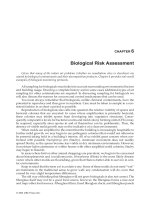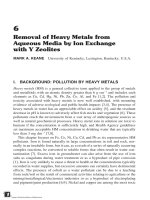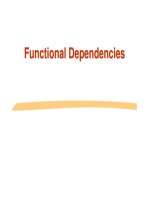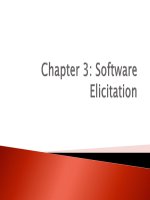Lecture Requirement engineering Chapter 6 Requirement validation
Bạn đang xem bản rút gọn của tài liệu. Xem và tải ngay bản đầy đủ của tài liệu tại đây (1.63 MB, 29 trang )
Requirements
Validation
Check that the right product is being
built
Refers to the set of activities that ensure
that software correctly
implements a specific function
Requirements
Verification
Check that product is being built right
refers to a different set of activities that
ensure that the software that has been
built is traceable to customer
requirements
2
Requirements
Verification and Validation
Techniques
Simple checks
Prototyping
Functional test design
User manual development
Reviews and inspections
Is
a whole life-cycle process - V & V must be
applied at each stage in the software process.
Has two principal objectives
The discovery of defects in a system;
The assessment of whether or not the system is
useful and useable in an operational situation.
4
Help ensure delivery of what the client wants
Need to be performed at every stage during the
(requirements) process
Elicitation
Checking back with the elicitation sources
Analysis
Checking that the domain description and requirements are correct
Specification
Checking that the defined system requirement will meet the user
requirements under the assumptions of the domain/environment
Checking conformity to well-formedness rules, standards…
Check
that the right product is being built
Ensures that the software being
developed (or changed) will satisfy its
stakeholders
Checks the software requirements
specification against stakeholders goals and
requirements
11/7/2014
6
Check
that product is being built right
Ensures that each step followed in the process
of building the software yields the right
products
Checks consistency of the software
requirements specification artefacts and other
software development products (design,
implementation, ...) against the specification
11/7/2014
7
Simple
checks
Prototyping
Functional test design
User manual development
Reviews and inspections
Model-Based V&V
8
Verify
that the requirements are well written
(according to the criteria already discussed)
Various checks can be done using traceability
techniques
Given the requirements document, verify that all
elicitation notes are covered
Tracing between different levels of requirements
Checking goals against tasks, features, requirements…
Involves developing a traceability matrix
Ensures that requirements have been taken into
consideration (if not there should be a reason)
Ensures that everything in the specification is justified
Excellent
for validation by users and customers
More accessible than specification
Demonstrate the requirements and help stakeholders
discover problems
Come
in all different shapes and sizes
From paper prototype of a computerized system to
formal executable models/specifications
Horizontal, vertical
Evolutive, throwaway
Important
to choose scenarios or use cases for
elicitation session
Prototyping-based validation steps
Choose prototype testers
Develop test scenarios
Careful planning is required to draw up a set of test
scenarios which provide broad coverage of the
requirements
Users should not just play around with the system as
this may never exercise critical system features
Execute test scenarios
Document problems using a problem reporting tool
Same reasoning as for functional
Has to be done at some point
Reveals problems earlier
test design
Forces
a detailed look at requirements
Particularly useful if the application is rich in user
interfaces / for usability requirements
Typical information in a user manual
Description of the functionality
How to get out of trouble
How to install and get started with the system
A
group of people read and analyze requirements,
look for potential problems, meet to discuss the
problems, and agree on a list of action items needed
to address these problems
A widely used requirements validation technique
Lots of evidence of effectiveness of the technique
Can
be expensive
Careful planning and preparation
Pre-review checking
Need appropriate checklists (must be developed if
necessary and maintained)
Different
types of reviews with varying degrees of formality
exist (similar to JAD vs. brainstorming sessions)
Reading the document
A person other than the author of the document
Reading and approval (sign-off)
Encourages the reader to be more careful (and responsible)
Walkthroughs
Informal, often high-level overview
Can be led by author/expert to educate others on his/her work
Formal inspections
Very structured and detailed review, defined roles for
participants, preparation is needed, exit conditions are defined
E.g., Fagan Inspection
14
Different
types of reviews
Focused inspections
Reviewers have roles, each reviewer looks only
for specific types of errors
Active reviews
Author asks reviewer questions which can only
be answered with the help of the document to be
reviewed
Plan
review
The review team is selected and a time and place for the
review meeting is chosen
Distribute
documents
The requirements document is distributed to the review
team members
Prepare
for review
Individual reviewers read the requirements to find conflicts,
omissions, inconsistencies, deviations from standards, and
other problems
Hold
review meeting
Individual comments and problems are discussed and a set
of action items to address the problems is established
Follow-up actions
The chair of the review checks that the agreed action items have been
carried out
Revise document
Requirements document is revised to reflect the agreed action items
At this stage, it may be accepted or it may be re-reviewed
•
Reviews should involve a number of
stakeholders drawn from different
backgrounds
– People from different backgrounds
bring different
skills and knowledge to the review
– Stakeholders feel involved in the RE process and
develop an understanding of the needs of other
stakeholders
– Review team should always involve at least a
domain expert and a user
Requirements clarification
The requirement may be badly expressed
or may have
accidentally omitted information which has been collected during
requirements elicitation
Missing information
Some information is missing from the
requirements document
Requirements conflict
There is a significant conflict between requirements
The stakeholders involved must negotiate to resolve the conflict
Unrealistic requirement
The requirement does not appear to be implementable
with the
technology available or given other constraints on the system
Stakeholders must be consulted to decide how to make the
requirement more realistic
Reviews
can be expensive because they
involve many people over several hours
reading and checking the requirements
document
We can reduce this cost by asking someone to
make a first pass called the pre-review
Check the document and look for straightforward
problems such as missing requirements (sections),
lack of conformance to standards, typographical
errors, etc.
Reviewer
is asked to use the specification
Author poses questions for the reviewer to
answer that can be answered only by reading
the document
Author may also ask reviewer to simulate a
set of scenarios
Essential
tool for an effective review process
List common problem areas and guide reviewers
May include questions an several quality aspects of the
document: comprehensibility, redundancy,
completeness, ambiguity, consistency, organization,
standards compliance, traceability ...
There
are general checklists and checklists for
particular modeling and specification languages
Checklists are supposed to be developed and
maintained
Functional
tests at the system level must be
developed sooner or later...
Designing these tests may reveal errors in the
specification (even before designing and
building the system)
Some software development processes (e.g.,
agile methods) begin with tests before
programming Test-Driven Development
(TDD)
Defect
testing
Tests designed to discover system defects.
A successful defect test is one which reveals the
presence of defects in a system.
Validation
testing
Intended to show
that the software meets its
requirements.
A successful test is one that shows that a
requirements has been properly implemented.









